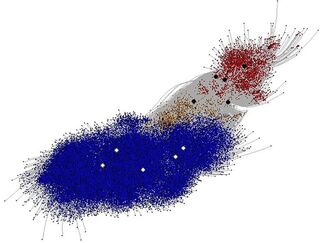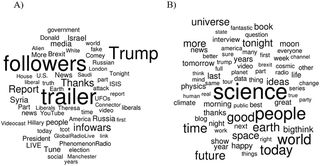Cognition
The Language of Conspiracy Theorists
Conspiracy theorists use unique patterns in their language, new research shows.
Posted June 8, 2021 Reviewed by Chloe Williams
Key points
- Belief in conspiracy theories is widespread: 50 percent of people in the U.S. endorsed at least one kind of conspiracy theory in 2014.
- Top conspiracy theorists on Twitter are more likely to use words that signal negative emotions, especially anger and fear, a recent study shows.
- Conspiracy theorists are also more likely to talk about themes related to death, power, religion, and "other" groups.
We have all come across plenty of conspiracy theories on the internet, from faked moon landings to the idea that 5G radiation is worsening or even causing COVID-19 symptoms. But belief in conspiracy theories is no longer reserved for the fringes of society. For example, already back in 2014, 50 percent of the U.S. population endorsed at least one kind of conspiracy theory and a recent poll from YouGov indicates that 28 percent of Americans think that Bill Gates is responsible for the pandemic so that he can use vaccination programs to inject people with location-tracking microchips.
Negative societal consequences
The dangerous societal consequences of growing public belief in conspiracy theories are well documented, from decreased civic engagement, to lower support for important issues such as global warming, to outright science denial, prejudice, and racism. In a recent study covering five different countries, we found that higher endorsement of conspiracy theories about COVID-19 (such as the idea that the virus was intentionally created in a military lab) is also strongly associated with lower intentions to get vaccinated and comply with public health guidelines.
Tracing digital footprints
Although tons of research has been conducted on why people believe in conspiracy theories, what research so far hasn't looked at is what language conspiracy theorists use online to entice their followers. Are there unique psycho-linguistic features in how actual conspiracy theorists express themselves online that we can discern from data? Most research uses surveys to ask the general public about the degree to which they endorse a particular conspiracy theory. Instead, we decided not to ask any questions and take our research online by observing the actual language that the top conspiracy theorists and their followers use on social media.
The language patterns of conspiracy theorists
In our new study, we first identified the top conspiracy theorists on Twitter via a simple popularity metric: their number of followers. After all, more followers means greater influence. Even though it's public information, we can't divulge the identities of the conspiracy theorists in question for ethical reasons but you can find a table with redacted Twitter profiles here. Of course, we needed to be able to compare the language used by conspiracy theorists to another group. So our comparison or control group consisted of the top popular science influencers. This is interesting insofar we can now compare how two opposing narratives unfold on social media: science versus conspiracy. In total, we were able to scrape over 16,000 tweets from the influencers and over 160,000 tweets from a random sample of about 1,600 of their followers. Lots of data to look at!
So what were we looking for?
We used a psychological tool known as the Linguistic Inquiry and Word Count (LIWC) dictionary. This dictionary was created by psychologist James Pannebaker who famously said "The words we use in daily life reflect who we are and the social relationships we are in." The dictionary associates words with particular psychological language themes. For example, a category called "cognitive processes" has subcategories that include "certainty" and associated words would include things like "truth." Similarly, the category "negative emotion" has subcategories called "anger" with associated words like "hate." Emotions such as "anxiety" would be associated with words like "nervous" and "afraid." The dictionary also clocks words that are about groups, for example, "we" and "us" versus "they" and "them." We used these categories to see if there are consistent patterns.
The figure below visualizes a snapshot of the social network of the top conspiracy theorists and popular science influencers and their respective following. You can already see that they form relatively polarized "echo chambers" with few linkages between the conspiracy and science influencers. Might they therefore also differ in the language that they use online?

We found some notable differences. For example, as compared to scientists, conspiracy theorists scored much higher on their use of negative emotion, especially anger and anxiety, and this pattern was also present among their followers, especially around words that signal anxiety. Conspiracy theorists were not necessarily more likely to use "certain" or "causal" language than scientists but their followers were more focused on past events. Interestingly, conspiracy theorists and their followers were especially likely to focus on language themes related to power, death, and religion, as well as a focus on other groups.
This makes sense: Many conspiracy theories revolve around the death of prominent individuals from Princess Diana, Osama Bin Laden, and John F. Kennedy to rapper Tupac Shakur. Conspiracy theories also frequently involve plots among powerful elites such as Bill Gates, Big Pharma, and international organizations such as the World Health Organization and United Nations who are seen as part of a "New World Order." The main purpose of conspiracy theories is of course to spread anger and fear, especially about the motives of other groups in society, including ethnic minorities, who are often the target of conspiracy theories.
In the figure below, we show a word cloud visualizing the most commonly used nouns and adjectives for the top 10 conspiracy and science influencers. Bigger and bolder representation indicates that the words appeared more frequently in the text. There are clear differences between the two groups, whereas scientists focus on science and topics such as “people,” “time,” “future,” “space,” “world,” “good,” and “earth,” conspiracy theorists focus on “followers,” “trailer” (of conspiracy movies), “Trump,” “Infowars,” “Russia,” “UFOs,” and “report.”

In short, next time you have a conversation and you're lured into a theme of fear, anxiety, and narratives about death and powerful "other" groups, you might be dealing with a conspiracy theorist.
References
Fong, A., Roozenbeek, J., Goldwert, D., Rathje, S., & van der Linden, S. (2021). The language of conspiracy: A psychological analysis of speech used by conspiracy theorists and their followers on Twitter. Group Processes & Intergroup Relations, 24(4), 606-623.
Further Reading
van der Linden, S., Panagopoulos, C., Azevedo, F., & Jost, J. T. (2021). The paranoid style in American politics revisited: An ideological asymmetry in conspiratorial thinking. Political Psychology, 42(1), 23-51.
van der Linden, S. (2015). The conspiracy-effect: Exposure to conspiracy theories (about global warming) decreases pro-social behavior and science acceptance. Personality and Individual Differences, 87, 171-173.
van der Linden, S. (2013). What a hoax. Scientific American Mind, 24(4), 40-43.




